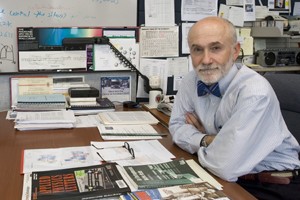
Salmon Garnish Points the Way to Green Electronics
Professor Andrew Steckl, a leading expert in light-emitting diodes, is intensifying the properties of LEDs by introducing biological materials, specifically salmon DNA.
Electrons move constantly think of tiny particles with a negative charge and attention deficit disorder. It is through the movement of these electrons that electric current flows and light is created.
Steckl is an Ohio Eminent Scholar in UCs Department of Electrical and Computer Engineering. He believed that if the electrons mobility could be manipulated, then new properties could be revealed.
In considering materials to introduce to affect the movement of the electrons, Steckl evaluated the source of materials with an eye to supply, especially materials that do not harm the environment.
Biological materials have many technologically important qualities electronic, optical, structural, magnetic, says Steckl. But certain materials are hard for us to duplicate, such as DNA and proteins. He also wanted a source that was widely available, would not have to be mined, and was not subject to any organization or countrys monopoly. His answer?
Salmon sperm.

Applied Physics Letter cover
Salmon sperm is considered a waste product of the fishing industry. Its thrown away by the ton, says Steckl with a smile. Its natural, renewable and perfectly biodegradable. While Steckl is currently using DNA from salmon, he thinks that other animal or plant sources might be equally useful. And he points out that for the United States, the green device approach takes advantage of something in which we continue to be a world leader agriculture.
Steckl is pursuing this research in collaboration with the Air Force Research Laboratory. The research was featured recently in such premier scientific publications as the inaugural issue of naturephotonics and on the cover of Applied Physics Letters.
The Air Force had already been working with DNA for other applications when they came to us and said, We know that you know how to make devices, quotes Steckl. They also knew that they had a good source of salmon DNA. It was a match made in heaven.

Diagram detail from APL cover
So began Steckls work with BioLEDs, devices that incorporate DNA thin films as electron blocking layers. Most of the devices existing today are based on inorganic materials, such as silicon. In the last decade, researchers have been exploring using naturally occurring materials in devices like diodes and transistors.
The driving force, of course, is cost: cost to the producer, cost to the consumer and cost to the environment Steckl points out, but performance has to follow.
And what a performance lights, camera, action!
DNA has certain optical properties that make it unique, Steckl says. It allows improvements in one to two orders of magnitude in terms of efficiency, light, brightness because we can trap electrons longer.
When electrons collide with oppositely charged particles, they produce very tiny packets of light called photons.
Some of the electrons rushing by have a chance to say hello, and get that photon out before they pass out, Steckl explains. The more electrons we can keep around, the more photons we can generate. Thats where the DNA comes in, thanks to a bunch of salmon.

BioLEDs make colors brighter.
DNA serves as a barrier that affects the motion of the electrons, says Steckl. It allows Steckl and his fellow researcher, the Air Forces Dr. James Grote, to control the brightness of the light that comes out.
The story continues, says Steckl, again smiling. Im receiving salmon sperm from researchers around the world wanting to see if their sperm is good enough. The next step is to now replace some other materials that go into an LED with biomaterials. The long-term goal is be able to make green devices that use only natural, renewable and biodegradable materials.
This research was funded by the United States Air Force.
Here we have the yin of biological materials in photonic devices. See Steckls yang research placing electronics in biological materials: UC Engineering Research Widens Possibilities for Electronic Devices: NSF-funded engineering research on microfluidics at the University of Cincinnati widens the possibilities on the horizon for electronic devices.
Related Stories
UC recognizes students for innovation achievement and leadership
April 30, 2025
Read about the University of Cincinnati’s undergraduate innovation awards for 2025.
Mechanical engineering scholarship honors alumnus
April 28, 2025
An estate gift from Pringle and her husband, Thomas Pringle, honors Sullivan with the creation of the Harold Richard Sullivan Endowed Scholarship Fund. The scholarship supports mechanical engineering students at the UC College of Engineering and Applied Science with a preference to students who are current or former service members of the U.S. Armed Forces.
UC Chicago Alumni to be honored at annual Chicagoans for Cincy!...
April 25, 2025
The University of Cincinnati Alumni Association and the Chicagoans for Cincy! Celebration committee, a group of dedicated alumni living in the Chicago area, will honor three outstanding Bearcats at this year’s annual Chicagoans for Cincy! Celebration. The event will take place Thursday, May 8, at 6 p.m. at Loft Lucia in Chicago’s West Loop neighborhood.
